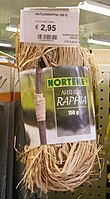Raffia palm
| Raffia palm | |
|---|---|

| |
| Scientific classification | |
| Kingdom: | Plantae |
| Clade: | Tracheophytes |
| Clade: | Angiosperms |
| Clade: | Monocots |
| Clade: | Commelinids |
| Order: | Arecales |
| Family: | Arecaceae |
| Subfamily: | Calamoideae |
| Tribe: | Lepidocaryeae |
| Genus: | Raphia P.Beauv. |
Raffia palmsare members of the genusRaphia.TheMalagasynamerafiais derived fromfia"to squeezejuice".[2]Thegenuscontains about twenty species ofpalmsnative to tropical regions of Africa, and especiallyMadagascar,with one species (R. taedigera) also occurring inCentraland South America.[1]R. taedigerais the source of raffia fibers, which are theveinsof the leaves, and this species produces a fruit called "brazilia pods", "uxi nuts" or "uxi pods".[3]
They grow up to 16 metres (52 ft) tall and are remarkable for theircompound pinnateleaves,the longest in the plant kingdom; leaves ofR. regalisup to 25 metres (82 ft) long[4]and 3 metres (9.8 ft) wide are known. The plants aremonocarpic,meaning that they flower once and then die after the seeds are mature. Some species have individual stems which die after fruiting, but have a root system which remains alive and sends up new stems which fruit.
Cultivation and uses
[edit]Fiber
[edit]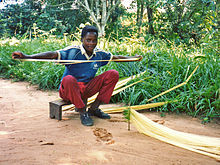
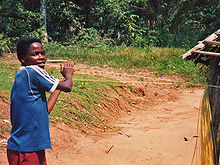
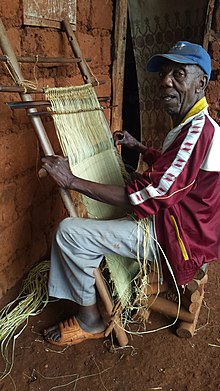
Raffia fiber is produced from theepidermalmembraneon the underside of the leaf fronds. The membrane is taken off to create a long thin fiber, which can be rolled together for added strength before they are finally dried. Fibres can be made intotwine,rope,garden ties, and used in tree grafting.[2][5]Fibres are important in the area of textiles, as they can be dyed and woven into products such as decorativemats,baskets,placemats,hats, and shoes.
Raffia wine
[edit]The sap of the palm can befermentedinto raffia wine.[2]It is traditionally collected by cutting a box in the top of the palm and suspending a large gourd below to collect the milky white liquid. Unlike withoil palms,this process kills the tree. Sap from both the raffia and oil palms can be allowed to ferment over a few days. When first collected from the tree, it is sweet and appears slightly carbonated. As it ages more sugar is converted. Raffia wine tends to be sweeter at any age when compared to oilpalm wine.Both kinds of palm wine can also be distilled into strong liquors, such asOgogoro.Traditionally in some cultures where raffia or oil palm are locally available, guests and spirits are offered these drinks from the palm trees.[citation needed]
Other uses
[edit]In local construction, raffia fibres are used for ropes, with branches and leaves providing sticks and supporting beams, and various roof coverings.[2]The people of Ogba kingdom in Rivers State and other southern Nigerians use raffia palm fronds as fishing poles. The frond is usually cut from a young palm tree. The leaves are removed and the stake is dried, which becomes very light, and the hook is attached to a line, which is tied to the stake, making it a fishing pole.[citation needed]
The raffia palm is important in societies such as that of the Province ofBoholin the Philippines,KubaofDemocratic Republic of the Congo,NsoofCameroon,theIgboandIbibio/Annang/BahumonoofSoutheastern Nigeria,theTivofNorthcentral NigeriaandSouthwestern Cameroons,the Urhobo andIjaw peopleof the Niger deltaNigeriaand theYoruba peopleof southwestern Nigeria, among several other West Africanethnicnations.[citation needed]
Synthetic raffia
[edit] |
A strand of raffia has a maximum length of about 1.5 m and an irregular width. When found onspoolsorhanksof greater lengths, it is likely synthetic raffia, produced frompolypropylene.First produced byCovemain collaboration withSulzer,a manufacturer of flat weaving looms for natural fibers, who adapted their looms to process synthetic raffia. These fabrics are used to make carpet backing, protective sheets, and bags for rice, potatoes, and citrus fruit. Covema also developed a method to cover raffia fabric with a thin film ofpolyethylenein order to make it waterproof.[6] |
-
Raffia can be used in tree grafting
-
Kuba raffia clothpanel
-
Raffia is woven to make the traditional Munganji dancer suit used inBapendeceremonies in the Gungu region ofBandundu Province,Democratic Republic of the Congo
-
Raphia animals in Madagascar
Species
[edit]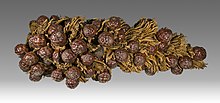
| Image | Scientific name | Distribution |
|---|---|---|
| Raphia africanaOtedoh | Nigeria, Cameroon | |
 |
Raphia australisOberm. & Strey | Mozambique, South Africa |
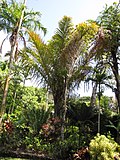 |
Raphia farinifera(Gaertn.) Hyl. | Africa from Senegal to Tanzania, south to Mozambique and Zimbabwe |
| Raphia gentilianaDe Wild. | Democratic Republic of Congo, Central African Republic | |
| Raphia hookeriG.Mann & H.Wendl. | western and central Africa from Liberia to Angola | |
| Raphia laurentiiDe Wild. | Angola, Democratic Republic of Congo, Central African Republic | |
| Raphia longifloraG.Mann & H.Wendl. | from Nigeria to Democratic Republic of Congo | |
| Raphia mambillensisOtedoh | Nigeria, Cameroon, Central African Republic, Sudan | |
| Raphia manniiBecc. | Nigeria, Bioko | |
| Raphia matombeDe Wild. | Cabinda, Democratic Republic of Congo | |
| Raphia monbuttorumDrude | Nigeria, Cameroon, Chad, Central African Republic, South Sudan | |
| Raphia palma-pinus(Gaertn.) Hutch. | western Africa from Liberia to Cabinda | |
| Raphia regalisBecc. | central Africa from Nigeria to Angola | |
| Raphia rostrataBurret | Cabinda, Democratic Republic of Congo | |
| Raphia ruwenzoricaOtedoh | eastern Democratic Republic of Congo, Rwanda, Burundi | |
| Raphia seseDe Wild. | Democratic Republic of Congo | |
 |
Raphia sudanicaA. Chev. | western Africa from Senegal to Cameroon |
 |
Raphia taedigera(Mart.) Mart. | Nigeria, Cameroon, Central America (Costa Rica, Nicaragua, Panama), South America (Colombia, Pará State of Brazil) |
| Raphia textilisWelw. | Cabinda, Democratic Republic of Congo, Gabon, Angola | |
| Raphia viniferaP. Beauv. | western Africa from Democratic Republic of Congo to Benin |
References
[edit]- ^abKew World Checklist of Selected Plant Families
- ^abcdBoiteau, Pierre(1999)."rafia".Dictionnaire des noms malgaches de végétaux(in French). Vol. I. Editions Alzieu. p. 196.
- ^Tucker, A.; Redford, A.; Scher, J.; Trice, M. (2010)."Raphia taedigera".Dried Botanical ID.Fort Collins, CO: Delaware State University, Identification Technology Program, CPHST, PPQ, APHIS, USDA.Retrieved7 October2016.
- ^Hallé, F. 1977. The longest leaf in palms?Principes21:18.
- ^"Natural Raffia – Your New Go-to Material in Fair Fashion - One of a Mind by ABURY".abury.net.Retrieved2021-09-10.
- ^Baucia, Giovanni."C'era una volta...l'estrusione".Polimerica.it(in Italian). Cronoart Srl.Retrieved21 October2021.

